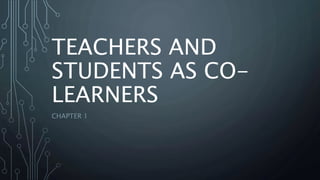
1_Teachers & Students as Co-Learners_Ausa, E_04-03-2023.pptx
- 1. TEACHERS AND STUDENTS AS CO- LEARNERS CHAPTER 1
- 2. BACKGROUND 1 WE ARE ALL LEARNERS This encourage students to expose and help to repair the many flaws in the education system and in the world’s current body of knowledge. Help students develop an attitude of constructive criticism.
- 3. STRATEGY 1 CELEBRATE NEGATIVE FEEDBACK Even if we suspect that students give the feedback with less than constructive intentions, we should respond as though the feedback was given with the best of intentions. “Treat people as they are and they will remain as they are. Treat people as they can and should be and they will become as they can and
- 4. BACKGROUND 2 THE EFFECTS OF EXPECTATIONS Pygmalion Effect High Expectations Improved Performance Low Expectations Worsened Performance When students think they are being taught by high quality teachers, the students seem to learn more, and vice versa.
- 5. STRATEGY 2 SHOW THAT WE’RE LIFE-LONG LEARNERS The class should be engaging about: what we think we have learned how we learned it what we still want to know
- 6. BACKGROUND 3 TEACHERS SHARE ABOUT THEMSELVES This fits with the concept of Learning Community (Roth and Lee 2006), where the main goal is the learning, and a feeling of human community promotes that goal. Connecting new knowledge to what we already know and have experienced.
- 7. STRATEGY 3 MAKE CONNECTIONS TO OUR OWN LIVES Text-to-text connections Text-to-world connections Text-to-self connections
- 8. BACKGROUND 4 SAGES VERSUS GUIDES The student centered paradigm seeks to involve teachers and students in collaboratively “performing” for each other, rather than teachers doing all the performing. “Those who teach learn twice”
- 9. STRATEGY 4 LET STUDENTS TEACH In this technique, students are first taught a set of comprehension strategies. They then take turns playing the role of teacher, teaching their peers how to use these strategies.
- 10. BACKGROUND 5 LISTEN TO LEARN Listen to your students.
- 11. STRATEGY 5 TAKE TIME TO UNDERSTAND WHAT STUDENTS ARE TRYING TO SAY “Seek to understand before seeking to be understood.” As we strive to understand what students are trying to communicate, we should look for the good and build on that.
- 12. BACKGROUND 6 BUILDING ON STUDENT’S EXPERIENCES One way for students to teach us teachers is to talk about topics that students know but we teachers do not. In this role reversing process, students learn about explaining clearly and patiently, while teachers are reminded how it feels to be the ones receiving help.
- 14. BACKGROUND 7 JOURNALING Students’ journal entries often benefit from feedback, which can come from teachers and from peers. This feedback should focus on ideas, not on matters such as punctuation, grammar, and spelling
- 15. STRATEGY 7 ASK STUDENTS TO WRITE JOURNALS
- 16. BACKGROUND 8 SHARING OUR LEARNING WITH OUR STUDENTS STRATEGY 8 TELL STUDENTS WHAT WE ARE READING/VIEWING
- 17. BACKGROUND 9 SEE OUR TEACHING THROUGH STUDENT’S EYES STRATEGY 8 ASK STUDENTS TO EVALUATE
Editor's Notes
- Also, cognitive psychologists tell us that we humans learn by connecting new knowledge to what we already know and have experienced. By telling a bit about ourselves, teachers model the making of those connections.
- Connections play a powerful role in constructing knowledge. Students can make connections between what they have just read and something they read or viewed previously (text-to-text connections) and the world around them (text-to-world connections), but also to their own personal lives and experiences (text-to-self connections). Text-to-world connections can also be built by making a time during class for students to share information they find relating to the topic the class is studying.
- In this metaphor, students are the passive customers, waiting to be entertained, except that stand-up comedians seldom give tests to their audiences; that wouldn’t be very funny. SCL seeks to change this paradigm from “sage on the stage” to “guide on the side.” “We teachers seem be the ones who are exhausted at the end of the day, while the students rest their bodies and minds.” In contrast, the student centered paradigm seeks to involve teachers and students in collaboratively “performing” for each other, rather than teachers doing all the performing—until test time. Students benefit from performing, because performers are the active, thinking ones. Similarly, there’s a saying that “Those who teach learn twice.” We learn by teaching others. We learn by being active. Let’s all of us, teachers and students, go home exhausted but satisfied.
- As the saying goes, “Seek to understand before seeking to be understood.” Besides, as we strive to understand what students are trying to communicate, we should look for the good and build on that. Another useful strategy is to give students a bit more time when they try to answer our questions. Giving students a wait time of around 3–5 s can make a lot of difference in the quality of their answers. Too often, teachers become impatient and wait for one second or less!
- One way for students to teach us teachers is to talk about topics that students know but we teachers do not. With such topics, roles are temporarily reversed, with students being the ones with more knowledge, and teachers depending on students. In this role reversing process, students learn about explaining clearly and patiently, while teachers are reminded how it feels to be the ones receiving help. Also, many students are very shy to ask for help, but maybe if we ask them first, students will feel more comfortable asking us.
- think about topics on which students might know more than us. Examples might be their families, their past experiences, culture popular among their age group, their opinions, their daily habits, the electronic devices and software they use, and where they live